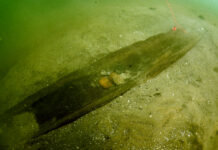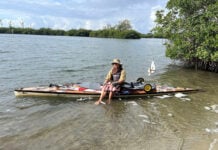On Thursday, August 14, 2025 the US Coast Guard (USCG) issued an urgent marine broadcast after being notified via VHF channel 16 that 12 kayakers were in distress between Patos Island and Sucia Island in the northern portion of Washington’s San Juan Islands.
The group included six minors and the rescue involved three agencies.
Kayakers rescued with no injuries in the San Juan Islands
Royal Canadian Mounted Police (RCMP) patrolling nearby responded along with nearby Washington State Park authorities and the USCG to retrieve the kayakers and transport the kayaks on their vessels. According to a statement from RCMP, two families had gone out on an overnight guided kayak trip and were returning when they experienced challenging conditions.

“Realizing that the conditions had surpassed their capabilities to safely continue the trip, they made the prudent decision to call for help before the situation worsened,” shared RCMP.
RCMP reported that all 12 of the kayakers were safely rescued and brought back to Orcas Island with no injuries reported, adding that the kayakers were understandably shaken by the ordeal.
The kayakers chose to call for help as conditions deteriorated beyond their skill level using a handheld VHF radio on channel 16, the channel for international distress and safety. Noted by RCMP, key to the successful rescue was the early decision to call for assistance as conditions surpassed the group’s skill and comfort level rather than after the situation had become more dire.
“A VHF marine radio is a mariner’s lifeline when there is no cell phone service,” shared Captain Micheal Hunt deputy commander, Coast Guard Sector Puget Sound in a statement. “It proved its worth by helping save lives in the San Juan Islands.”
How to call the Coast Guard
While cell phones can be a useful tool for calling for help, when cell service fails a marine radio can be a key factor in initiating a rescue for kayakers.
Steps to call for help in an emergency via a VHF include turning your radio to channel 16 then initiating a call. Next, repeat the word “mayday” three times, then repeat the name of/or description of your vessel three times followed by “mayday” once more. From here, give your position as specifically as you can using GPS coordinates or landmarks. Finally, state the nature of your distress, the kind of assistance needed, number of people involved, and any information that could aid in your rescue. Conclude the call with the word “over”.
Importantly, even if you can not remember the precise radio protocol in an emergency you can still call the Coast Guard for assistance on Channel 16. Beyond a radio and a cell phone, other signaling devices kayakers can consider carrying include a whistle, a signaling mirror, flares, strobe lights, or handheld GPS.









The specific area of this incident is a challenging spot for currents. Currents wrap around islands and are not linear or exactly predictable. There is a shallow bank where an ebb current against opposing wind can create steep and confused chop. This group was out at maximum ebb (moderate on that date, but still significant) with an opposing wind (as forecasted). This could easily create conditions too challenging for underpowered, loaded tandems. Conditions don’t look bad in the photos, but the group may already have drifted out of the worst of it by the time they were rescued. Mistakes may have been made to attempt that route with the forecasted currents and wind with the added element of weak paddlers. The decision to call for help before things got worse was a good call. Hopefully the guides and outfitter learned from this.
Thanks for filling us in with important, useful, local knowledge.
It’s good that they made the call and were easily rescued.
There’s a lot missing from the story, though. What was their intended and actual route? What were the predicted and actual condidtions? (The image appears to show only light chop.) How many guides were there and what was the skill level of the guides?
If the conditions were worse than the least experienced member of the group was comfortable with then they made the right call.
I wouldn’t call those challenging conditions at all. Where are the white caps, the six foot swells?
Weather station data indicates that on the afternoon of Aug. 14 there were wind gust around 19 knots on the Strait of Georgia. Not a good situation with kids.